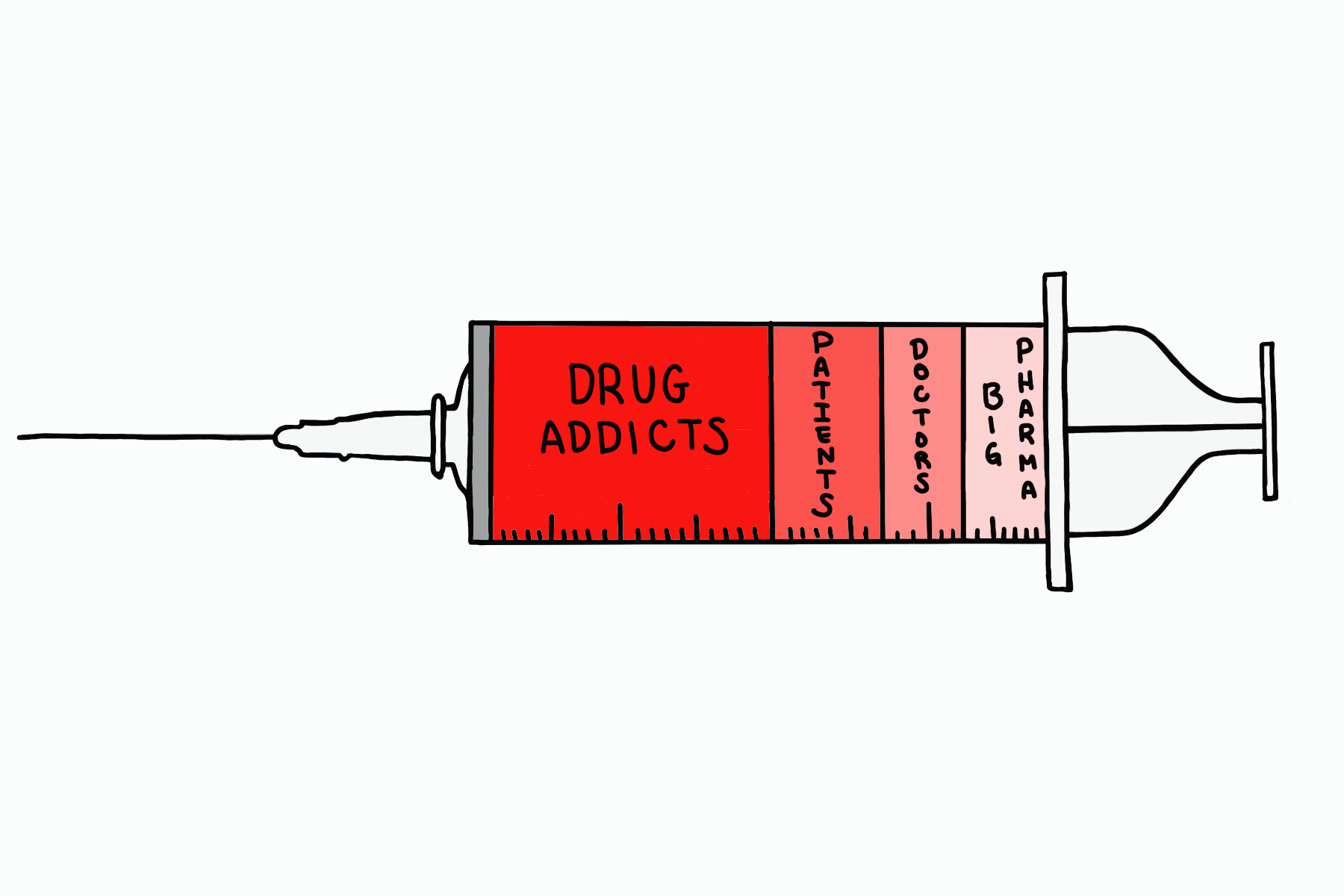
Pharmaceutical companies push opioids into the public sphere as if they were injecting them right into the arms of the patients themselves. Opioids are made from natural drugs that are found in the poppy plant and are used to treat pain. There are three types of opioids: prescription (like OxyContin and Vicodin), fentanyl, and heroin. They are all common in the United States, and they are all incredibly addictive. Although they are used medically to treat severe pain, like other drugs, they are also associated with a “high.”[1]
The U.S. government declared the opioid problem a “national health emergency” in 2018.[2] In the past 20 years, 450,000 Americans have died from opioid-related causes.[3] May 2020 marked the highest number of drug overdose deaths in the U.S. in a twelve-month period, at over 81,000 deaths.[4] Even though synthetic opioids are driving the increases in recent years, most illicit use of opioids starts with the abuse of prescription pills.[5] In 2019, 40% of opioid overdoses involved the use of prescription drugs. [6] In American capitalist society, the pharmaceutical companies are big money makers, but at what cost?
Pharma to Blame
In the late 1990s, physicians began prescribing opioids at higher rates. While they reassured their patients that they would not get addicted to these prescription pain relievers, there was not enough data to back up that statement. As a result, there was widespread misuse. Since then, opioid fatalities have been rising every year. [7]
A Jama Network study from 2019 found that counties receiving direct opioid marketing from pharmaceutical companies had higher mortality rates from opioid overdoses. This means that this “direct-to-physician marketing” is not only associated with an increase in opiate prescriptions but may also be associated with an increase in opioid-related deaths.[12]
After much public outcry and media attention on the opioid crisis, the number of opioid prescriptions has declined by 37.3% since 2013. [8] Nevertheless, pharmaceutical companies continue to aggressively market opioid drugs to physicians, giving incentives to prescribe more.[9] Purdue Pharma, a leading pharmaceutical company, started selling OxyContin in the mid-90s. This drug is now known to be one of the early drivers of the epidemic.[10] Since 2004, McKinsey & Company, a marketing consulting firm, has been advising Purdue to focus on marketing OxyContin because it is incredibly lucrative, while deliberately downplaying the known risks of the drug.[11]
How can it end?
The problem is that pharmaceutical companies appear to value profits over the well-being of the people. For the patient, prescription painkillers are an accessible and helpful form of relief for chronic pain. For Big Pharma, they are a massive money maker, and the companies will seize the opportunity to maximize profits wherever possible.
Congress passed the Opioid Crisis Accountability Act in May 2019 to hold pharmaceutical companies accountable for any “dubious” behavior regarding marketing and distribution of opioid products.[13] It seems like this act might be working. Purdue is one of several major companies that have had to file for bankruptcy in the past year due to opioid litigations. Now, Purdue and McKinsey have both pled guilty and agreed to a $600 million settlement in a lawsuit over their direct involvement in driving the sales of OxyContin.[14] Hopefully we will see more of these companies exposed and tried for their role in the opioid epidemic.
The pharmaceuticals are only one element of the crisis now, but it is also how it all started 20 years ago. Being able to control Big Pharma will help in controlling the epidemic.
WORKS CITED:
“Drug Overdose Deaths.” Center for Disease Control and Prevention, accessed April 27, 2021. https://www.cdc.gov/drugoverdose/data/statedeaths.html
Forsythe, Michael and Walt Bogdanich, “McKinsey Settles for Nearly $600 Million over Role in Opioid Crisis.” New York Times, Feb. 3, 2021. https://www.nytimes.com/2021/02/03/business/mckinsey-opioids-settlement.html
Hadland SE, Rivera-Aguirre A, Marshall BDL, Cerdá M. “Association of Pharmaceutical Industry Marketing of Opioid Products With Mortality From Opioid-Related Overdoses.” JAMA Netw Open. 2019;2(1):e186007. doi:10.1001/jamanetworkopen.2018.6007
Hoffman, Jan and Katie Benner. “Purdue Pharma Pleads Guilty to Criminal Charges for Opioid Sales. New York Times, Oct. 21, 2020. https://www.nytimes.com/2020/10/21/health/purdue-opioids-criminal-charges.html
Madras BK. “The Surge of Opioid Use, Addiction, and Overdoses: Responsibility and Response of the US Health Care System.” JAMA Psychiatry. 2017;74(5):441–442. doi:10.1001/jamapsychiatry.2017.0163
“Opioid Addiction.” Johns Hopkins Medicine, accessed April 26, 2021, https://www.hopkinsmedicine.org/opioids/treating-opioid-addiction.html
Opioid Crisis Accountability Act of 2019, H.R.2917, https://www.congress.gov/116/bills/hr2917/BILLS-116hr2917ih.xml
“Opioid Overdose Crisis.” National Institute on Drug Abuse, accessed April 26, 2021, https://www.drugabuse.gov/drug-topics/opioids/opioid-overdose-crisis
“Overdose Deaths Accelerating During Covid-19.” Centers for Disease Control and Prevention, accessed April 26, 2021,https://www.cdc.gov/media/releases/2020/p1218-overdose-deaths-covid-19.html
[1] “Opioid Addiction.” Johns Hopkins Medicine, accessed April 26, 2021.
[2] “Overdose Crisis.” National Institute
[3] “Opioid Overdose Crisis.” National Institute on Drug Abuse, accessed April 26, 2021.
[4] “Overdose Deaths Accelerating During Covid-19.” Centers for Disease Control and Prevention, accessed April 26, 2021.
[5] Madras BK. “The Surge of Opioid Use, Addiction, and Overdoses: Responsibility and Response of the US Health Care System.”
[6] “Drug Overdose Deaths.” Center for Disease Control and Prevention, accessed April 27, 2021.
[7] “Overdose Crisis.” National Institute
[8] “Opioid Overdose Crisis.” National Institute on Drug Abuse, accessed April 26, 2021.
[9]Hadland SE, Rivera-Aguirre A, Marshall BDL, Cerdá M. “Association of Pharmaceutical Industry Marketing of Opioid Products With Mortality From Opioid-Related Overdoses.”
[10] Hoffman, Jan and Katie Benner. “Purdue Pharma Pleads Guilty to Criminal Charges for Opioid Sales. New York Times, Oct. 21, 2020.
[11] Forsythe, Michael and Walt Bogdanich, “McKinsey Settles for Nearly $600 Million over Role in Opioid Crisis.” New York Times, Feb. 3, 2021.
[12] Hadland, “Association of Pharmaceutical Industry”
[13] Opioid Crisis Accountability Act of 2019, H.R.2917
[14] Hoffman, “Purdue Pharma.”